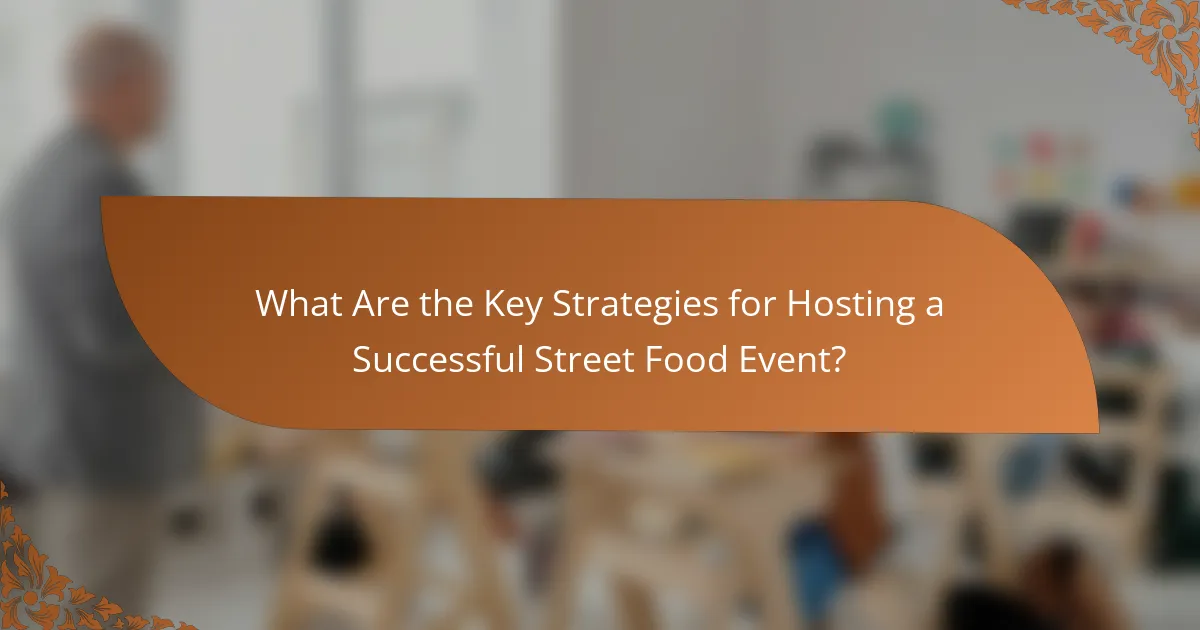Hosting a successful street food event requires careful planning and execution, focusing on effective marketing, engaging local vendors, and establishing a unique theme. Selecting the right location is essential to maximize foot traffic and accessibility, while ensuring compliance with necessary permits and licenses will safeguard your event’s success. By prioritizing these key strategies, you can create an unforgettable experience that attracts and delights attendees.

What Are the Key Strategies for Hosting a Successful Street Food Event?
To host a successful street food event, focus on effective marketing, engaging local vendors, and creating a unique theme. These strategies will help attract attendees, enhance the experience, and ensure a memorable occasion.
Effective marketing techniques
Utilizing a mix of traditional and digital marketing strategies is crucial for promoting your street food event. Consider distributing flyers in local neighborhoods, collaborating with local businesses, and leveraging community boards to spread the word.
Online, use targeted ads on platforms like Facebook and Instagram to reach your audience. Highlight unique food offerings and entertainment options to draw interest.
Engaging local vendors
Partnering with local food vendors not only supports the community but also enhances the event’s appeal. Reach out to a diverse range of vendors, including those offering unique cuisines or specialty items that reflect local culture.
Ensure that vendors understand the event’s goals and audience, and provide them with clear guidelines on setup, health regulations, and expected attendance to foster a collaborative environment.
Creating a unique theme
A well-defined theme can set your street food event apart from others. Consider themes that resonate with local culture, seasonal celebrations, or specific culinary styles to create a cohesive experience.
Incorporate decorations, music, and activities that align with the theme to enhance the atmosphere and encourage attendees to engage with the event.
Utilizing social media
Social media is a powerful tool for promoting your street food event and engaging with potential attendees. Create event pages on platforms like Facebook and Instagram to share updates, vendor highlights, and sneak peeks of the food offerings.
Encourage attendees to share their experiences using a dedicated hashtag, which can help increase visibility and attract a larger audience.
Offering diverse food options
Providing a variety of food options is essential to cater to different tastes and dietary preferences. Include vegetarian, vegan, and gluten-free choices to ensure inclusivity and attract a wider audience.
Consider offering tasting portions or sample sizes to encourage attendees to try multiple dishes, enhancing their overall experience and increasing vendor sales.

How to Choose the Right Location for Your Street Food Event?
Choosing the right location for your street food event is crucial for attracting attendees and ensuring a successful turnout. Consider factors such as accessibility, foot traffic, and local regulations to create an inviting atmosphere that encourages participation.
Accessibility for attendees
Accessibility is key to ensuring that all potential attendees can easily reach your event. Look for locations that are near public transportation options, such as bus or subway stations, and have ample parking for those driving. Additionally, consider wheelchair accessibility and pathways that are easy to navigate.
Evaluate the surrounding infrastructure, including sidewalks and crosswalks, to ensure safe access. A location that is easy to get to can significantly increase attendance and enhance the overall experience.
Proximity to foot traffic
Choosing a location close to high foot traffic areas can greatly enhance visibility and draw in more attendees. Ideal spots include busy shopping districts, parks, or near popular attractions where people naturally congregate. The more people passing by, the higher the chances of spontaneous visits.
Monitor local events or activities that might coincide with your event date, as these can either boost foot traffic or create competition. Aim for a location that complements existing crowds rather than competing for attention.
Local permits and regulations
Understanding local permits and regulations is essential for hosting a street food event legally and smoothly. Research the specific permits required for food vendors in your area, as these can vary significantly by city or region. Common permits include health permits, vendor licenses, and event permits.
Check with local authorities well in advance to ensure compliance with health and safety regulations. Failing to secure the necessary permits can lead to fines or even event cancellation, so it’s best to be proactive in this regard.

What Are the Essential Permits and Licenses Needed?
To host a successful street food event, obtaining the necessary permits and licenses is crucial. These requirements can vary by location but generally include health department permits, vendor licenses, and event insurance.
Health department permits
Health department permits are essential for ensuring food safety at your event. These permits typically require vendors to meet specific hygiene standards and may involve inspections prior to the event. It’s advisable to apply for these permits well in advance, as processing times can vary from a few days to several weeks.
Check with your local health department for specific requirements, as they can differ significantly by state or municipality. Some areas may require food handlers’ certifications or additional documentation for certain food types.
Vendor licenses
Vendor licenses authorize food vendors to sell their products at your event. Each vendor may need to obtain their own license, which often involves submitting an application and paying a fee. The cost and requirements can vary widely, typically ranging from $50 to several hundred dollars depending on the location and type of food sold.
Ensure that all vendors are aware of the licensing requirements in your area. It’s beneficial to compile a checklist of necessary documents and fees to streamline the process for each vendor.
Event insurance requirements
Event insurance protects against potential liabilities during your street food event. Many venues or municipalities require proof of insurance before granting permits. Coverage typically includes general liability, which can range from $1 million to $2 million, depending on the scale of the event.
Consider consulting with an insurance agent who specializes in event coverage to ensure you meet all requirements. Additionally, check if vendors need to provide their own insurance or if they can be covered under your policy.

How to Budget for a Street Food Event?
Budgeting for a street food event involves estimating all potential costs to ensure financial viability. Key areas to consider include vendor costs, marketing expenses, venue rental fees, and staffing logistics.
Estimating vendor costs
Vendor costs typically include fees for food, equipment, and supplies. Depending on the number of vendors and the type of cuisine, these costs can range from a few hundred to several thousand dollars. It’s crucial to negotiate terms and understand what each vendor provides in their fee.
Consider offering incentives for vendors to participate, such as reduced fees for early commitments or a percentage of sales. This can help manage upfront costs while ensuring a diverse food selection.
Marketing expenses
Marketing expenses are vital for attracting attendees to your street food event. Budget for online advertising, social media promotions, and printed materials like flyers and posters. A reasonable marketing budget might range from 10% to 20% of your total budget.
Utilize local influencers and community groups to spread the word. Collaborating with them can enhance your reach without significantly increasing costs.
Venue rental fees
Venue rental fees can vary widely based on location, size, and amenities. Expect to pay anywhere from a few hundred to several thousand dollars for a suitable space. Research local regulations regarding permits and insurance, as these may add to your costs.
Consider public parks or community spaces, which may offer lower rental fees compared to commercial venues. Always confirm what utilities are included in the rental agreement to avoid unexpected expenses.
Staffing and logistics
Staffing and logistics encompass the costs of hiring personnel and managing event operations. This may include security, cleanup crews, and event coordinators. Depending on the size of your event, staffing costs can range from a few hundred to several thousand dollars.
Plan for logistics such as waste management, restroom facilities, and first aid stations. Creating a checklist of necessary services can help ensure you don’t overlook any critical aspects that could impact your budget.

What Are Effective Ways to Promote Your Street Food Event?
Promoting your street food event effectively involves leveraging various channels to reach your target audience. Focus on engaging local communities and utilizing digital platforms to create buzz and attract attendees.
Collaborating with influencers
Partnering with local influencers can significantly enhance your event’s visibility. Influencers often have dedicated followings that trust their recommendations, making them powerful allies in promotion.
Identify influencers who align with your event’s theme and audience. Reach out to them with a clear proposal that outlines mutual benefits, such as free food samples or exclusive access to the event. This collaboration can include social media posts, stories, or even live coverage during the event.
Utilizing local media
Engaging local media outlets is a crucial strategy for promoting your street food event. Newspapers, radio stations, and community blogs often seek interesting stories and events to feature, providing you with a platform to reach a broader audience.
Prepare a press release that highlights the unique aspects of your event, such as featured vendors, special activities, or community involvement. Distribute this to local journalists and media contacts at least a few weeks in advance. Consider offering exclusive interviews or behind-the-scenes access to entice media coverage.
